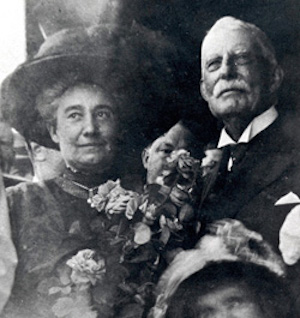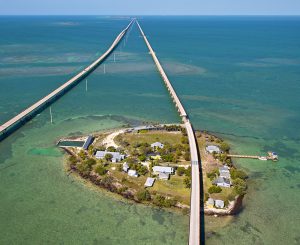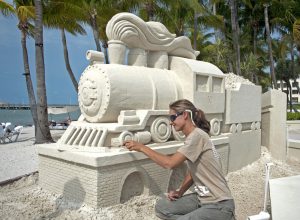On Jan. 22, 1912, when Ruby Whitlock was eight years old, she watched the arrival of the first train that ever traveled down the Florida Keys Over-Sea Railroad tracks from mainland Florida to Key West.

Henry Flagler and his wife Mary Lily were honored at celebrations marking the arrival of the railroad’s first train in Key West. (Photo courtesy of the Monroe County Library Collection)
Eighty-eight years later, when she was an energetic 96-year-old, “Miss Ruby” reminisced about the arrival that changed the Keys forever.
These days, when it’s possible to drive from Key West to Miami in about four hours on the Florida Keys Overseas Highway, it’s hard to imagine the Keys not being comfortably linked to each other — and to the mainland.
But they weren’t until Henry Flagler, called a visionary by some contemporaries and a madman by others, conceived and built the miraculous “railroad that went to sea.”
Construction began in 1905. The railroad’s track ultimately stretched more than 100 miles out into open water, requiring trailblazing techniques and unbelievable effort by a crew that sometimes numbered more than 4,000 men. Flagler had made his fortune as John D. Rockefeller’s partner in Standard Oil, and he gambled most of it on the venture — a venture so extraordinary that many outsiders thought it was impossible.
It was officially named the Florida East Coast Railway’s Key West Extension, but it quickly became known as the Florida Keys Over-Sea Railroad. Its bridges and viaducts linking the Keys, including the astonishing Seven Mile Bridge at Marathon, earned it another title: “the eighth wonder of the world.”
“That was a great day when that train came in here,” recalled Miss Ruby, who was believed to be the last remaining Key Wester to witness the historic arrival.
“I was going to Harris School, and the Harris School kids went down to meet the train,” she said. “Everybody was hollering and whooping, throwing bouquets, hoisting up flags and singing, saying, ‘There’s the train! There’s the train!’ All of Key West was happy that day.”

Pigeon Key, once a base camp for the workers that constructed the Florida Keys Over-Sea Railroad, lies beneath the original Seven Mile Bridge. (Photo by Andy Newman, Florida Keys News Bureau)
Key West had every right to be happy. The debut of the railroad transformed it from an isolated outpost, accessible only by boat, to a destination easily reached by both passengers and freight.
“I remember it like it was yesterday,” said Miss Ruby. “Dr. Fogarty was the mayor, and he made a speech when the train came in. I can see him now, and I can see old Flagler with his straw hat on.”
Flagler himself, however, never saw the joyful crowds.
When the first train from the mainland pulled into the Key West terminal, its elderly creator stepped out of his private car. He was greeted by dignitaries, citizens and hordes of schoolchildren — all cheering his fantastic accomplishment.
By then almost blind, he stood with tears streaming down his face.
“I can hear the children,” he said, “but I cannot see them.”
Less than 16 months later, at age 83, he died.

Sand sculptor Marianne van den Broek finalizes a creation that salutes the historic Florida Keys Over-Sea Railroad at Key West’s Casa Marina Resort. (Photo by Rob O’Neal, Florida Keys News Bureau)
Over the next two decades, Henry Flagler’s Over-Sea Railroad carried half a million visitors across the miles separating mainland Florida and Key West. Unfortunately, it only lasted for 23 years before being severely damaged in a 1935 hurricane.
While the Florida Keys Overseas Highway links the mainland and the Keys today, many of the original railroad bridges can still be seen — massive and stark — stretching beside the highway’s bridges.
Other reminders can be found on Pigeon Key, a five-acre island that housed workers building the original Seven Mile Bridge. Pigeon Key’s buildings have been carefully restored, and visitors can take historical tours and explore an intriguing museum. There’s also a permanent railroad exhibit titled “Overseas to the Keys” at the Key West Museum of Art & History at the Custom House.
Henry Flagler and Ruby Whitlock, of course, are both long gone. But the Overseas Highway is a federally designated an All-American Road, regarded as one of the United States’ great “bucket list” drives. And everyone who takes that drive is following the path blazed by the iconic railroad — conceived by the visionary Flagler and celebrated by eight-year-old Ruby more than a century ago.

